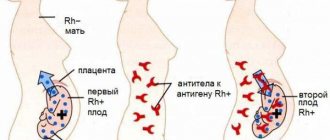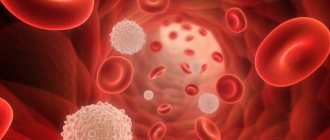Oncologist
Lobov
Mikhail Yurievich
Experience 27 years
Oncologist
Make an appointment
Hodgkin's lymphoma is one of the types of lymphomas, malignant diseases. Their peculiarity is that the growth of a malignant formation begins from lymphoid tissue. The disease is localized in the lymph nodes and does not invade the bone marrow for quite a long time. In fact, Hodgkin's lymphomas include a whole group of diseases - they account for 40% of all lymphomas. It is impossible to distinguish the two groups from each other visually or by other simple means. But Hodgkin's diseases are determined by analysis - during the examination, specific Berezovsky-Sternberg-Reed cells are found in the patient.
Symptoms
The first symptoms of Hodgkin's lymphoma include weakness, sweating (intensifies at night), high temperature (38 degrees and above). Because colds and flu have these symptoms, people often don't take them seriously. But then the picture gets worse: the patient begins to lose weight, his lymph nodes enlarge. They become dense and do not cause pain upon palpation.
Other symptoms of Hodgkin lymphoma also include:
- Pain in the lymph nodes when drinking alcohol.
- Severe itching for no particular reason and a more active reaction of the body to insect bites (compared to what was before).
- Difficulty breathing, swallowing.
- Swelling of veins at the level of the neck and head.
The last two signs of Hodgkin lymphoma accompany more serious stages, so it is impossible not to notice them. If treatment is not started at this point, then more serious problems will develop: intestinal obstruction, enlarged spleen, kidney problems, etc. Kidney and heart failure may develop. Against the background of a weakened body, infections often occur - and their pathogens are absolutely not dangerous for a healthy person.
How is Hodgkin's disease diagnosed?
1. The appearance of enlarged, painless lymph nodes, often in the neck, less often in other locations
2. Enlarged lymph nodes in the chest cavity can cause compression of the trachea, which may be accompanied by coughing and shortness of breath.
3.Fever, debilitating night sweats and weight loss.
4. In addition, itching of the skin, fatigue, and loss of appetite may occur.
If such symptoms appear, you should immediately consult a doctor and undergo an examination. Although these symptoms can also occur with other diseases.
The first step is a complete physical examination and thorough examination to rule out infection. During the examination, the doctor will pay special attention to the condition of the lymph nodes. Given that most people, especially children, have swollen lymph nodes due to infection, your doctor may prescribe antibiotics to shrink the nodes. If such an effect is not observed, then further examination is necessary.
The only method to confirm the diagnosis of HD is a biopsy, i.e. taking a piece of tumor tissue for examination. In some cases, it is necessary to remove the entire lymph node or a small part of it. A specialist examines the resulting material under a microscope. In some cases, the initial biopsy does not confirm the diagnosis and a repeat biopsy becomes necessary.
Causes
As with other cancers, the exact causes of Hodgkin lymphoma in children and adults cannot be determined. But there are several theories. The first suggests that it's all about genetics - that is, family heredity plays a role. The second suggests that lymphoma of this type can be caused by some severe infections that the patient had previously suffered. And the third theory comes down to the fact that lymphocytes change spontaneously, under the influence of various stimulants.
Since no one knows the exact causes, there can be no specific prevention in this case - unfortunately, no one is immune from this disease.
How has the therapy changed?
Until the 60s of the 20th century, they did not know how to treat Hodgkin’s lymphoma; patients were simply irradiated with high doses of radiation. Then they began to try chemotherapy, and the first treatment protocols appeared. Then they began to combine chemistry with radiation, reducing its dose. In the 90s, a breakthrough occurred when new imaging methods appeared: CT and MRI. The idea in recent years has been to identify a group with a favorable prognosis already at the diagnostic stage: these patients can be treated not very strongly and not very toxic. At the same time, modern therapy assumes maximum effectiveness at any stage and risk group, the main thing is to vary the intensity. The principle now is that if after two courses of chemotherapy the tumor is PET-negative (that is, its foci are not detected during a PET study), it does not need to be irradiated. If it remains positive, it needs to be irradiated, even if the initial stage of the disease was small.
As for irradiation, there were also breakthroughs here. Previously, the dose was higher, and the whole body was irradiated, then they began to irradiate with so-called “extended fields”. The better primary diagnostics developed, the better we saw the affected area and the more sophisticated the irradiation methods became. Radiation now hits exactly the target, and when prescribing treatment, radiation therapists calculate how much radiation is given to the tumor itself, how much radiation is given to nearby areas, and how much tissue will receive that should not receive it at all.
Stages
According to one of the popular and widespread classifications, there are four stages of Hodgkin lymphoma (and zero). We will not describe their symptoms, but how the patient feels at each stage:
- 0th. A person feels and behaves as if he is absolutely healthy.
- I. The patient can lead a completely adequate lifestyle, but he is slightly weakened, so physical labor is limited.
- II. Severe fatigue is already noticeable, the person cannot take care of himself, it is difficult for him to move. The patient may spend about half the day in bed.
- III. At this stage, the patient lies a lot (more than half a day) and needs constant care. It is difficult for him to be active and perform even usual actions.
- IV. At this stage, patients are the sickest. They constantly lie or sit, get tired extremely quickly and can even communicate with difficulty and for a short time.
The doctor will explain to the patient what processes occur in the body at each stage of Hodgkin lymphoma - there are many manifestations and their details. It all starts with damage to the lymph nodes or some organs (for example, the spleen) - and then the tumor begins to spread, gradually taking over the body.
Classification of Hodgkin's lymphoma (lymphogranulomatosis)
The 2021 revised WHO classification of tumors of hematopoietic and lymphoid tissues distinguishes two types of Hodgkin lymphoma: classical Hodgkin lymphoma and nodular lymphoid-predominant Hodgkin lymphoma.
Classic Hodgkin lymphoma includes the following histological variants:
- variant with nodular sclerosis (types I and II),
- mixed cell version,
- classic version with a large number of lymphocytes,
- variant with lymphoid depletion (rare).
Diagnostics
Timely diagnosis of Hodgkin lymphoma is extremely important - the sooner the correct diagnosis is made, the greater the patient’s chances of recovery.
To clarify all the details, the patient is prescribed:
- Chest X-ray, MRI, PET, ultrasound. Various organs are examined, and in many cases the entire body.
- Puncture and tissue biopsy of affected lymph nodes or organs.
- Various tests that help find out if there are additional problems - for example, HIV, viral hepatitis or something else.
It is not always possible to make a diagnosis quickly: additional examinations and a consultation of doctors are often required, who collectively decide what they are dealing with - this is especially true for non-standard cases, which occur quite often.
How is pathology diagnosed?)
If the presence of a disease is suspected, doctors at the Oncology Center prescribe a number of laboratory and instrumental examinations:
- a thorough medical examination of the patient to assess the severity of signs of a malignant tumor of the lymphatic system;
- laboratory blood test, including general blood test, biochemical blood test, immunoglobulins, etc.;
- examination of organs and lymph nodes of the thoracic and abdominal cavities using high-resolution chest radiography in two projections and ultrasound of the abdominal cavity or computed tomography (if indicated, positron emission tomography combined with computed tomography);
- biopsy of a lymph node or other lesion, morphological examination of biopsy material using immunohistochemical methods;
- For patients with classical Hodgkin lymphoma, with the exception of patients with classical Hodgkin lymphoma stage IA without signs of bone marrow involvement according to PET/CT, it is recommended to obtain a histological preparation of bone marrow (trephine biopsy), morphological examination of bone marrow biopsy material using immunohistochemical methods to clarify the stage of the tumor process.
In addition, the patient may be prescribed additional examination methods, including:
- magnetic resonance imaging;
- endoscopic examination;
- bone tissue scintigraphy.
Treatment
To ensure that treatment for Hodgkin's lymphoma is as effective as possible, it is prescribed individually and depending on the stage. In the early stages of the disease, radiotherapy (radiation) is usually used. Usually it takes about a month of treatment and then remission is possible. At more serious stages, chemotherapy is added - its duration and types of drugs vary, much depends on the patient. Hormonal medications may also be prescribed.
In difficult situations, patients are indicated for surgical intervention - removal of a tumor, spleen, etc. The decision about surgery is made on the basis of current clinical recommendations for Hodgkin lymphoma - there are specific prerequisites for this.
Proper nutrition plays an important role in recovery for Hodgkin lymphoma. It should be balanced, with a sufficient amount of vitamins, but without heavy food for the body. Small and frequent meals are encouraged, which will always be varied.
If you observe symptoms of a dangerous disease in yourself or your loved ones, or you know for sure that it already exists, a consultation with JSC “Medicine” will help you decide on a further plan of action. Our oncologists are always happy to answer questions and provide qualified assistance.
Criteria for assessing the completeness of remission
Criteria for assessing remission are needed by the doctor to determine the need to continue treatment or intensify therapy programs, or transfer the patient under dynamic observation.
- Complete remission - complete regression of all signs of the disease (clinical, hematological and other manifestations of the disease) according to imaging tests, determined twice with an interval of at least 4 weeks.
- Partial remission is a reduction in the size of tumor formations by at least 50% for a period of 4 weeks in the absence of new lesions.
- Stabilization of the disease is a reduction in the size of tumor formations by less than 50% or an increase in them by no more than 25% of the original volume in the absence of new lesions.
- Progression is the appearance of new lesions during treatment or an increase in previously existing ones by more than 25%, as well as the appearance of symptoms of intoxication.
- Relapse is the appearance of new lesions after achieving complete remission.
Why does lymphogranulomatosis occur?
The exact causes of the disease have not been established. There are several triggers for Hodgkin's disease:
- genetic predisposition, when the disease is hereditary;
- previously suffered severe infectious diseases;
- spontaneous change in lymphocytes, provoked by exposure to viruses or taking medications that suppress the immune system.
Factors that provoke the disease include:
- the effect of radiation;
- working with harmful substances - pesticides, herbicides, solvents, benzenes;
- living in regions with poor ecology.
Since the exact causes of this type of lymphoma are unknown, there is no special prevention.
Complete victory?
Relapses exist; according to time, they are divided into early and late. In order to understand how and with what to treat them, it was decided to identify risk groups for them.
- If the stage of the disease was small and the relapse was late, this is a low risk group.
- If the stage was large, but the relapse was late, this is an intermediate risk group.
- Advanced stages of the disease and early relapse are considered high or very high risk.
Groups 1 and 2 will most likely require chemotherapy and possibly radiation. For the third and fourth cases, bone marrow transplantation is indicated - usually autologous, that is, the patient will be transfused with his own stem cells. In addition, if there is no response to standard therapy, chemotherapy regimens with newer, and therefore expensive, drugs can be used. We are talking about Adcetris, Opdivo or Keytrud. They cost hundreds of thousands of rubles, and we really need the help of philanthropists: everyone who supports our patients and gives them a chance for a normal life no matter what.
Get a free consultation
Leading specialists of the Center will answer your questions.
To get a consultation
Find out the price
Hodgkin's lymphoma (lymphogranulomatosis, LGM, Hodgkin's disease) is one of the types of lymphomas. This disease affects the lymphatic system, which consists of lymph nodes that are connected by blood vessels. Occurring in one group of lymph nodes, malignant cells can spread to other groups, and in later stages of the disease - to internal organs.










